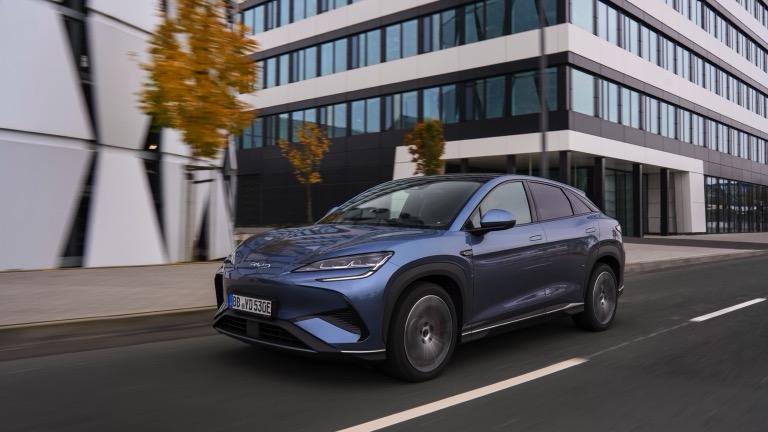
August’s new-vehicle figures show a renewed surge in electric vehicle (EV) uptake across Australia, with Chinese manufacturer BYD once again outselling Tesla and the overall EV share of the new-car market rising to 9.7 per cent. The Federal Chamber of Automotive Industries (FCAI) and the Electric Vehicle Council (EVC) data released in early September illustrate a market recovering from a subdued July and highlight an accelerating competitive shift driven by Chinese brands.
Key numbers and what they mean
- Battery-electric vehicle (BEV) registrations reported to FCAI’s vFacts totalled 6,848 in August.
- The EVC reported combined Tesla and Polestar sales of 3,155 for the month. Taken together, the FCAI and EVC figures point to an aggregate EV volume of about 10,003 for August against total vehicle sales of 103,694. That equates to the 9.7 per cent market share.
- Tesla’s deliveries dipped sharply in July, contributing to that month’s low EV share (6.9 per cent). The rebound in August was powered largely by BYD’s model line-up and broader supply stabilisation across other brands.
- Plug-in hybrid electric vehicles (PHEVs) declined for the second month running, with 3,906 PHEV sales in August, down from over 4,000 in July.
BYD’s strong month and the model leaderboard
BYD reported combined volumes across the SeaLion 7, Seal, Atto 3 and Dolphin that exceeded 3,000 units (3,064), narrowly outpacing Tesla’s 2,927 units for the period. The month’s model-by-model breakdown underscores BYD’s breadth of offerings and price competitiveness while Tesla retains blockbuster single-model performance:
Top-selling BEV models in August 2025 (reported totals)
- Tesla Model Y – 2,324
- BYD SeaLion 7 – 1,413
- BYD Seal – 623
- Tesla Model 3 – 603
- BYD Atto 3 – 594
- BYD Dolphin – 434
- Geely EX5 – 401
- Kia EV5 – 367
- Kia EV3 – 295
- MG MGS5 – 284
- Volkswagen ID.4 – 219
- Mercedes‑Benz EQE SUV – 166
Notes on data coverage and uncertainty
- Not all manufacturers report to both FCAI and EVC. Xpeng, for example, does not submit detailed monthly figures to those organisations, so total market volumes may be understated in public summaries. The inclusion of unreported brand figures could push EV share figures closer to (or above) the symbolic 10 per cent threshold for August.
- TheDriven and other industry outlets are continuing to reconcile manufacturer-reported figures; small adjustments are possible as additional disclosures arrive.
Structural shifts: four Chinese brands in the top 10
August marked the first month in which four Chinese brands featured in the top-10 list of best-selling EV brands in Australia. That placement signals a rapid evolution in consumer choice and value propositions: competitive pricing, extensive model ranges and strong inclusion of mainstream body styles (compact SUVs, sedans and city cars) have given Chinese entrants meaningful headway against established European, Korean and North American marques.
Market dynamics and commercial drivers
Several factors are driving the current picture:
- Model availability and volume: BYD’s multi-model push has broadened mainstream EV access, and steady deliveries have helped it eclipse Tesla at the brand level for the month. Tesla, however, continues to dominate single-model sales, notably with the Model Y.
- Price competition and incentives: August’s month-end promotions and factory incentives have intensified as brands chase market share ahead of year-end targets. Several manufacturers have signalled further incentives in September and beyond.
- Supply normalisation: The industry-wide constraints that characterised earlier parts of 2023-24 (chips, logistics) have largely eased, enabling more predictable deliveries. Tesla’s delivery cadence remains variable, which can sharply affect monthly tallies.
- Policy and regulatory environment: The Federal Chamber of Automotive Industries has again used the data opportunity to lobby for a comprehensive road user charge (RUC) to replace declining fuel excise revenues as vehicle fleets electrify and internal-combustion engines become more efficient. Governments and road authorities are debating RUC models and pilot schemes; any broad adoption would reshape long-term ownership costs for all vehicle types.
- Standards and emissions regulation: The New Vehicle Efficiency Standards (NVES) and other regulatory levers are encouraging manufacturers to accelerate low-emissions offerings into the Australian market, further boosting EV availability.
Charging infrastructure, consumer confidence and PHEV decline
Public and private investment in fast-charging infrastructure is expanding, with government programs and commercial operators deploying higher-capacity chargers across major highways and urban centres. Charging access, along with improved range and more mainstream models, is steadily raising consumer confidence.
The second consecutive monthly decline in PHEV sales suggests a market rotation toward full battery-electric vehicles rather than an outright collapse of hybrids. Buyers appear increasingly prepared to commit to fully electric models when value, range and charging convenience align.
Policy conversations: taxes, infrastructure and longer-term planning
FCAI chief executive Tony Weber reiterated the industry position that fuel excise revenue will erode as fleets electrify and that a durable, equitable funding mechanism for roads and charging infrastructure is required. The industry’s preferred approach would apply to all light vehicles to avoid unfairly penalising early EV adopters and to maintain road funding for decades to come. State and federal governments are weighing options; the details and timing of any RUC implementation will be crucial for fleet operators and consumers.
What to watch next
- September incentives and promotions as brands chase year-end volumes.
- Further data releases and reconciliations that may revise August totals, especially if non-reporting brands later disclose figures.
- Ongoing roll-out of high-power public chargers and any state or federal announcements on charging subsidies or infrastructure funding.
- Progress (or delay) in national discussions on road user charging and how any pilot programs might be structured.
- New model launches and the pace at which NVES and other regulatory settings influence manufacturers’ Australian line-ups.
Conclusion
August 2025 was a defining month for Australia’s EV transition: overall EV share rebounded to 9.7 per cent, BYD capitalised on model breadth to overtake Tesla at the brand level, and four Chinese brands broke into the top-10 – reflecting an increasingly competitive market. While monthly swings remain common, the trend is clear: more models, better supply and intensifying incentives are accelerating EV adoption. Policy debates over road funding and infrastructure will be pivotal in shaping the economics of ownership going forward. For consumers, that means more choice and, in the near term, improved value – and for policymakers, the urgent task is to ensure that road funding, grid readiness and charging infrastructure keep pace with a rapidly electrifying vehicle fleet.
FAQs
Q: How reliable are the August sales figures?
A: The figures are based on FCAI vFacts and EVC data released in early September 2025 and reflect the most up-to-date public reporting. Totals may be revised slightly if manufacturers that do not regularly report (for example Xpeng) disclose additional numbers. Industry reconciliations by outlets such as The Driven may provide refined monthly totals.
Q: Why did Tesla’s deliveries fall in July and rebound in August?
A: Tesla’s monthly deliveries can fluctuate due to production allocation, shipping schedules, and regional distribution priorities. A noticeable dip in July was followed by a recovery in August as deliveries normalised and other brands also adjusted volume.
Q: What is NVES and how does it affect the market?
A: NVES refers to policy measures aimed at improving vehicle fleet efficiency and encouraging lower-emissions models. Where applied, such standards can prompt manufacturers to accelerate EV and low-emissions model introductions to meet regulatory targets, increasing model choice and supply for Australian buyers.
Q: Will road user charges (RUCs) be introduced soon?
A: Governments and industry bodies are debating RUCs as a sustainable replacement for declining fuel excise revenue. While industry groups like the FCAI advocate for comprehensive RUC schemes, implementation will depend on political agreement, pilot programs, and design choices. Timelines remain unclear and vary by jurisdiction.
Q: Are Chinese brands undercutting established manufacturers on quality?
A: Chinese brands are competing strongly on price and feature content, and several now meet international safety and quality benchmarks. Consumer perceptions are improving as more long-term data on reliability, warranty coverage and dealer networks become available. Buyers should compare independent safety ratings, warranty terms and dealer support when evaluating options.
About EV Evolution
EV Evolution is the leading online platform dedicated to Australian electric vehicle owners and enthusiasts. We foster a vibrant community, delivering essential EV news and insights, and enhancing user engagement through our innovative, AI-powered chatbot for dynamic discussions. Our mission is to empower Australian electric vehicle owners and enthusiasts by fostering a vibrant, AI-driven online community that connects, informs, and advances the nation’s electric vehicle landscape.




